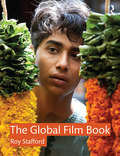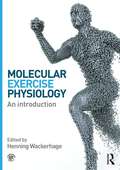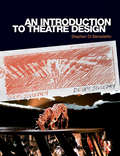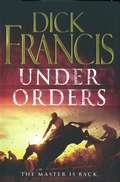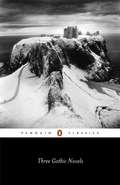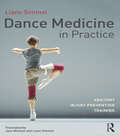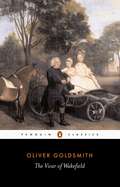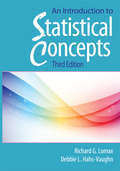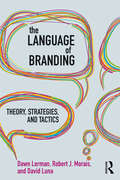- Table View
- List View
The Small House at Allington
by Anthony Trollope Julian ThompsonEngaged to the ambitious and self-serving Adolphus Crosbie, Lily Dale is devastated when he jilts her for the aristocratic Lady Alexandrina. Although crushed by his faithlessness, Lily still believes she is bound to her unworthy former fiancé for life and therefore condemned to remain single after his betrayal. And when a more deserving suitor pays his addresses, she is unable to see past her feelings for Crosbie. Written when Trollope was at the height of his popularity, The Small House at Allington (1864) contains his most admired heroine in Lily Dale - a young woman of independent spirit who nonetheless longs to be loved - and is a moving dramatization of the ways in which personal dilemmas are affected by social pressures.
The Global Film Book
by Roy StaffordThe Global Film Book is an accessible and entertaining exploration of the development of film as global industry and art form, written especially for students and introducing readers to the rich and varied cinematic landscape beyond Hollywood. Highlighting areas of difference and similarity in film economies and audiences, as well as form, genre and narrative, this textbook considers a broad range of examples and up to date industry data from Europe, Africa, Asia, Australasia and Latin America. Author Roy Stafford combines detailed studies of indigenous film and television cultures with cross border, global and online entertainment operations, including examples from Nollywood to Korean Cinema, via telenovelas and Nordic crime drama. The Global Film Book demonstrates a number of contrasting models of contemporary production, distribution and consumption of film worldwide, charting and analysing the past, present and potential futures for film throughout the world. The book also provides students with: a series of exploratory pathways into film culture worldwide illuminating analyses and suggestions for further readings and viewing, alongside explanatory margin notes and case studies a user friendly text design, featuring over 120 colour images a dynamic and comprehensive blog, online at www.globalfilmstudies.com, providing updates and extensions of case studies in the book and analysis of the latest developments in global film issues.
The Global Film Book
by Roy StaffordThe Global Film Book is an accessible and entertaining exploration of the development of film as global industry and art form, written especially for students and introducing readers to the rich and varied cinematic landscape beyond Hollywood. Highlighting areas of difference and similarity in film economies and audiences, as well as form, genre and narrative, this textbook considers a broad range of examples and up to date industry data from Europe, Africa, Asia, Australasia and Latin America. Author Roy Stafford combines detailed studies of indigenous film and television cultures with cross border, global and online entertainment operations, including examples from Nollywood to Korean Cinema, via telenovelas and Nordic crime drama. The Global Film Book demonstrates a number of contrasting models of contemporary production, distribution and consumption of film worldwide, charting and analysing the past, present and potential futures for film throughout the world. The book also provides students with: a series of exploratory pathways into film culture worldwide illuminating analyses and suggestions for further readings and viewing, alongside explanatory margin notes and case studies a user friendly text design, featuring over 120 colour images a dynamic and comprehensive blog, online at www.globalfilmstudies.com, providing updates and extensions of case studies in the book and analysis of the latest developments in global film issues.
Molecular Exercise Physiology: An Introduction
by Henning WackerhageMolecular Exercise Physiology: An Introduction is the first student-friendly textbook to be published on this key topic in contemporary sport and exercise science. It introduces sport and exercise genetics and the molecular mechanisms by which exercise causes adaptation. The text is linked to real life sport and exercise science situations such as ‘what makes people good at distance running?’, ‘what DNA sequence variations code for a high muscle mass?’ or ‘by what mechanisms does exercise improve type2 diabetes?’ The book includes a full range of useful features, such as summaries, definitions of key terms, guides to further reading, review questions, personal comments by molecular exercise pioneers (Booth, Bouchard) and leading research in the field, as well as descriptions of research methods. A companion website offers interactive and downloadable resources for both student and lecturers. Structured around central themes in sport and exercise science, such as nutrition, endurance training, resistance training, exercise & chronic disease and ageing, this book is the perfect foundation around which to build a complete upper-level undergraduate or postgraduate course on molecular exercise physiology.
Molecular Exercise Physiology: An Introduction
by Henning WackerhageMolecular Exercise Physiology: An Introduction is the first student-friendly textbook to be published on this key topic in contemporary sport and exercise science. It introduces sport and exercise genetics and the molecular mechanisms by which exercise causes adaptation. The text is linked to real life sport and exercise science situations such as ‘what makes people good at distance running?’, ‘what DNA sequence variations code for a high muscle mass?’ or ‘by what mechanisms does exercise improve type2 diabetes?’ The book includes a full range of useful features, such as summaries, definitions of key terms, guides to further reading, review questions, personal comments by molecular exercise pioneers (Booth, Bouchard) and leading research in the field, as well as descriptions of research methods. A companion website offers interactive and downloadable resources for both student and lecturers. Structured around central themes in sport and exercise science, such as nutrition, endurance training, resistance training, exercise & chronic disease and ageing, this book is the perfect foundation around which to build a complete upper-level undergraduate or postgraduate course on molecular exercise physiology.
Skill Acquisition in Sport (2nd Edition): Research, Theory and Practice
by Hodges, Nicola J.|Williams, A. MarkSuccess in sport depends upon the athlete's ability to develop and perfect a specific set of perceptual, cognitive and motor skills. Now in a fully revised and updated new edition, Skill Acquisition in Sport examines how we learn such skills and, in particular, considers the crucial role of practice and instruction in the skill acquisition process. Containing thirteen completely new chapters, and engaging with the significant advances in neurophysiological techniques that have profoundly shaped our understanding of motor control and development, the book provides a comprehensive review of current research and theory on skill acquisition. Leading international experts explore key topics such as: attentional focus augmented Feedback observational practice and learning implicit motor learning mental imagery training physical guidance motivation and motor learning neurophysiology development of skill joint action. Throughout, the book addresses the implications of current research for instruction and practice in sport, making explicit connections between core science and sporting performance. No other book covers this fundamental topic in such breadth or depth, making this book important reading for any student, scholar or practitioner working in sport science, cognitive science, kinesiology, clinical and rehabilitation sciences, neurophysiology, psychology, ergonomics or robotics.
Skill Acquisition in Sport (2nd Edition) (PDF): Research, Theory and Practice
by Hodges, Nicola J.|Williams, A. MarkSuccess in sport depends upon the athlete's ability to develop and perfect a specific set of perceptual, cognitive and motor skills. Now in a fully revised and updated new edition, Skill Acquisition in Sport examines how we learn such skills and, in particular, considers the crucial role of practice and instruction in the skill acquisition process. Containing thirteen completely new chapters, and engaging with the significant advances in neurophysiological techniques that have profoundly shaped our understanding of motor control and development, the book provides a comprehensive review of current research and theory on skill acquisition. Leading international experts explore key topics such as: attentional focus augmented Feedback observational practice and learning implicit motor learning mental imagery training physical guidance motivation and motor learning neurophysiology development of skill joint action. Throughout, the book addresses the implications of current research for instruction and practice in sport, making explicit connections between core science and sporting performance. No other book covers this fundamental topic in such breadth or depth, making this book important reading for any student, scholar or practitioner working in sport science, cognitive science, kinesiology, clinical and rehabilitation sciences, neurophysiology, psychology, ergonomics or robotics.
An Introduction to Theatre Design
by Stephen Di BenedettoThis introduction to theatre design explains the theories, strategies, and tools of practical design work for the undergraduate student. Through its numerous illustrated case studies and analysis of key terms, students will build an understanding of the design process and be able to: identify the fundamentals of theatre design and scenography recognize the role of individual design areas such as scenery, costume, lighting and sound develop both conceptual and analytical thinking Communicate their own understanding of complex design work trace the traditions of stage design, from Sebastiano Serlio to Julie Taymor. Demonstrating the dynamics of good design through the work of influential designers, Stephen Di Benedetto also looks in depth at script analysis, stylistic considerations and the importance of collaboration to the designer’s craft. This is an essential guide for students and teachers of theatre design. Readers will form not only a strong ability to explain and understand the process of design, but also the basic skills required to conceive and realise designs of their own.
Educational Leadership and Technology: Preparing School Administrators for a Digital Age
by Virginia E. Garland Chester TadejaProviding models of exemplary use and the latest research, Educational Leadership and Technology reveals the transformational power of emerging technologies to improve student learning, and explores how leaders can bring about this technology integration. This book provides an overview of roles and strategies expected of effective school leaders, as well as some of the complex issues they face. Authors Garland and Tadeja offer a critical analysis of today’s emerging technology, while also addressing the need for collaborative efforts of parents, community, and students to implement technologies effectively. Special Features Include: Full integration of National Technology Standards for Administrators (NETS.A) and the National Education Technology Plan (NETP). Leader reflections from practicing school administrators that provide context of real-world scenarios. "Tips for School Leaders" and end-of-chapter questions that encourage student engagement with the text. "School Administrator’s Technology Leadership Self-Assessment," a unique and impartial survey in each chapter with self-scoring guide that helps readers determine their technology use and readiness for implementation. A robust companion website with PowerPoint Slides, strategies, and links to website and video resources which will reflect changes in technology, policy, and practice. Discussion of the newest and emerging technologies, including Cloudware, social media, virtual manipulatives, and e-games. Educational Leadership and Technology is an important resource for new and aspiring elementary, middle, and high school principals as well as superintendents and technology coordinators.
Educational Leadership and Technology: Preparing School Administrators for a Digital Age
by Virginia E. Garland Chester TadejaProviding models of exemplary use and the latest research, Educational Leadership and Technology reveals the transformational power of emerging technologies to improve student learning, and explores how leaders can bring about this technology integration. This book provides an overview of roles and strategies expected of effective school leaders, as well as some of the complex issues they face. Authors Garland and Tadeja offer a critical analysis of today’s emerging technology, while also addressing the need for collaborative efforts of parents, community, and students to implement technologies effectively. Special Features Include: Full integration of National Technology Standards for Administrators (NETS.A) and the National Education Technology Plan (NETP). Leader reflections from practicing school administrators that provide context of real-world scenarios. "Tips for School Leaders" and end-of-chapter questions that encourage student engagement with the text. "School Administrator’s Technology Leadership Self-Assessment," a unique and impartial survey in each chapter with self-scoring guide that helps readers determine their technology use and readiness for implementation. A robust companion website with PowerPoint Slides, strategies, and links to website and video resources which will reflect changes in technology, policy, and practice. Discussion of the newest and emerging technologies, including Cloudware, social media, virtual manipulatives, and e-games. Educational Leadership and Technology is an important resource for new and aspiring elementary, middle, and high school principals as well as superintendents and technology coordinators.
Under Orders (Francis Thriller #40)
by Dick Francis‘Sadly, death at the races is not uncommon. However, three in a single afternoon was sufficiently unusual to raise more than an eyebrow.’It’s the third death on Cheltenham Gold Cup Day that really troubles super-sleuth Sid Halley. Former champion jockey Halley knows the perils of racing all too well – but in his day, jockeys didn’t usually reach the finishing line with three .38 rounds in the chest. But this is precisely how he finds jockey Huw Walker – who, only a few hours earlier, had won the coveted Triumph Hurdle.Just moments before the gruesome discovery, Halley had been called upon by Lord Enstone to make discrete enquiries into why his horses appeared to be on a permanent losing streak. Are races being fixed? Are bookies taking a cut? And if so, are trainers and jockeys playing a dangerous game with stakes far higher than they realise? Halley’s quest for answers draws him ever deeper into the darker side of the race game, in a life-or-death power play that will push him to his very limits – both professionally and personally.In his first new novel for six years, Dick Francis returns to prove once again that he is the Grand Master of thriller writing.
The Way We Live Now (Barnes And Noble Classics Ser.)
by Anthony Trollope Frank KermodeAugustus Melmotte is a fraudulent foreign financier who preys on dissolute nobility - using charm to tempt the weak into making foolish investments in his dubious schemes. Persuaded to put money into a notional plot to run a railroad from San Francisco to Santa Cruz, the capricious gambler Felix Carbury soon becomes one of his victims. But as Melmotte climbs higher in society, his web of deceit - which also draws in characters as diverse as his own daughter Marie and Felix's mother, the pulp novelist Lady Carbury - begins to unravel. A radical exploration of the dangers associated with speculative capitalism, this is a fascinating satire about a society on the verge of moral bankruptcy.
Three Gothic Novels (Penguin Modern Classics)
by Horace Walpole Mary Shelley William Beckford Peter Fairclough Mario PrazThe Gothic novel, which flourished from about 1765 until 1825, revels in the horrible and the supernatural, in suspense and exotic settings.This volume, with its erudite introduction by Mario Praz, presents three of the most celebrated Gothic novels: The Castle of Otranto, published pseudonymously in 1765, is one of the first of the genre and the most truly Gothic of the three. Vathek (1786), an oriental tale by an eccentric millionaire, exotically combines Gothic romanticism with the vivacity of The Arabian Nights and is a narrative tour de force. The story of Frankenstein (1818) and the monster he created is as spine-chilling today as it ever was; as in all Gothic novels, horror is the keynote.
Dance Medicine in Practice: Anatomy, Injury Prevention, Training
by Liane SimmelDance Medicine in Practice is the complete physical textbook for dance, written specifically to help dancers understand the anatomy, function and care of their bodies. Specific chapters are devoted to focusing on the spine, pelvis, hips, knees, feet, shoulders and arms. Each of these covers the following key aspects: Anatomy: bone structure, musculature, and function. How each part of the body moves and how it responds under pressure Pitfalls: Common examples of bad practice and the effect that these can have on the body Self Analysis: How to become aware of and muscle groups and the capacity of each joint. Injury Prevention: Tips and advice on how to best avoid and prevent injury both in training and everyday life Exercises: Simple and effective methods of strengthening, mobilising and relaxing joints and muscles Checklists: Dos and Don’ts for the best dance technique. The best dancers know that looking after their bodies is the key to their success, and Dance Medicine in Practice also covers how to ensure the best possible nutrition, plan and manage training schedules, and ensure that injuries are kept to a minimum both in frequency and impact. It is the best possible companion to a life in dance.
Dance Medicine in Practice: Anatomy, Injury Prevention, Training
by Liane SimmelDance Medicine in Practice is the complete physical textbook for dance, written specifically to help dancers understand the anatomy, function and care of their bodies. Specific chapters are devoted to focusing on the spine, pelvis, hips, knees, feet, shoulders and arms. Each of these covers the following key aspects: Anatomy: bone structure, musculature, and function. How each part of the body moves and how it responds under pressure Pitfalls: Common examples of bad practice and the effect that these can have on the body Self Analysis: How to become aware of and muscle groups and the capacity of each joint. Injury Prevention: Tips and advice on how to best avoid and prevent injury both in training and everyday life Exercises: Simple and effective methods of strengthening, mobilising and relaxing joints and muscles Checklists: Dos and Don’ts for the best dance technique. The best dancers know that looking after their bodies is the key to their success, and Dance Medicine in Practice also covers how to ensure the best possible nutrition, plan and manage training schedules, and ensure that injuries are kept to a minimum both in frequency and impact. It is the best possible companion to a life in dance.
Applied Statistics for the Social and Health Sciences (PDF)
by Rachel A. GordonApplied Statistics for the Social and Health Sciences provides graduate students in the social and health sciences with the basic skills that they need to estimate, interpret, present, and publish statistical models using contemporary standards. The book targets the social and health science branches such as human development, public health, sociology, psychology, education, and social work in which students bring a wide range of mathematical skills and have a wide range of methodological affinities. For these students, a successful course in statistics will not only offer statistical content but will also help them develop an appreciation for how statistical techniques might answer some of the research questions of interest to them. This book is for use in a two-semester graduate course sequence covering basic univariate and bivariate statistics and regression models for nominal and ordinal outcomes, in addition to covering ordinary least squares regression. Key features of the book include: interweaving the teaching of statistical concepts with examples developed for the course from publicly-available social science data or drawn from the literature thorough integration of teaching statistical theory with teaching data processing and analysis teaching of both SAS and Stata "side-by-side" and use of chapter exercises in which students practice programming and interpretation on the same data set and course exercises in which students can choose their own research questions and data set. This book is for a two-semester course. For a one-semester course, see http://www.routledge.com/9780415991544/
Adventure Therapy: Theory, Research, and Practice
by Michael A. Gass H.L. "Lee" Gillis Keith C. RussellThe evolution and history of adventure therapy, as chronicled in the second chapter of this book, well demonstrates how far this field has evolved from a “divergent therapy” into an efficacious form of therapy that engages clients on cognitive, affective, and behavioral levels. Adventure Therapy is written by three professionals who have been at the forefront of the field since its infancy. The theory, techniques, research, and case studies they present are the cutting edge of this field. The authors focus on:• the theory substantiating adventure therapy • illustrations that exemplify best practices • the research validating the immediate as well as long-term effects of adventure therapy, when properly conducted. This book is the leading academic text, professional reference, and training resource for adventure therapy practices in the field of mental health. It is appropriate for a wide range of audiences, including beginner and experienced therapists, as well as graduate students.
The Vicar of Wakefield: Der Landprediger Von Wakefield
by Oliver Goldsmith Stephen CooteWhen Dr Primrose loses his fortune in a disastrous investment, his idyllic life in the country is shattered and he is forced to move with his wife and six children to an impoverished living on the estate of Squire Thornhill. Taking to the road in pursuit of his daughter, who has been seduced by the rakish Squire, the beleaguered Primrose becomes embroiled in a series of misadventures - encountering his long-lost son in a travelling theatre company and even spending time in a debtor's prison. Yet Primrose, though hampered by his unworldliness and pride, is sustained by his unwavering religious faith. In The Vicar of Wakefield, Goldsmith gently mocks many of the literary conventions of his day - from pastoral and romance to the picaresque - infusing his story of a hapless clergyman with warm humour and amiable social satire.
Adventure Therapy: Theory, Research, and Practice
by Michael A. Gass H.L. "Lee" Gillis Keith C. RussellThe evolution and history of adventure therapy, as chronicled in the second chapter of this book, well demonstrates how far this field has evolved from a “divergent therapy” into an efficacious form of therapy that engages clients on cognitive, affective, and behavioral levels. Adventure Therapy is written by three professionals who have been at the forefront of the field since its infancy. The theory, techniques, research, and case studies they present are the cutting edge of this field. The authors focus on:• the theory substantiating adventure therapy • illustrations that exemplify best practices • the research validating the immediate as well as long-term effects of adventure therapy, when properly conducted. This book is the leading academic text, professional reference, and training resource for adventure therapy practices in the field of mental health. It is appropriate for a wide range of audiences, including beginner and experienced therapists, as well as graduate students.
An Introduction to Statistical Concepts: Third Edition
by Debbie L Hahs-Vaughn Richard G LomaxThis comprehensive, flexible text is used in both one- and two-semester courses to review introductory through intermediate statistics. Instructors select the topics that are most appropriate for their course. Its conceptual approach helps students more easily understand the concepts and interpret SPSS and research results. Key concepts are simply stated and occasionally reintroduced and related to one another for reinforcement. Numerous examples demonstrate their relevance. This edition features more explanation to increase understanding of the concepts. Only crucial equations are included.In addition to updating throughout, the new edition features: New co-author, Debbie L. Hahs-Vaughn, the 2007 recipient of the University of Central Florida's College of Education Excellence in Graduate Teaching Award. A new chapter on logistic regression models for today's more complex methodologies. More on computing confidence intervals and conducting power analyses using G*Power. Many more SPSS screenshots to assist with understanding how to navigate SPSS and annotated SPSS output to assist in the interpretation of results. Extended sections on how to write-up statistical results in APA format. New learning tools including chapter-opening vignettes, outlines, and a list of key concepts, many more examples, tables, and figures, boxes, and chapter summaries. More tables of assumptions and the effects of their violation including how to test them in SPSS. 33% new conceptual, computational, and all new interpretative problems. A website that features PowerPoint slides, answers to the even-numbered problems, and test items for instructors, and for students the chapter outlines, key concepts, and datasets that can be used in SPSS and other packages, and more. Each chapter begins with an outline, a list of key concepts, and a vignette related to those concepts. Realistic examples from education and the behavioral sciences illustrate those concepts. Each example examines the procedures and assumptions and provides instructions for how to run SPSS, including annotated output, and tips to develop an APA style write-up. Useful tables of assumptions and the effects of their violation are included, along with how to test assumptions in SPSS. 'Stop and Think' boxes provide helpful tips for better understanding the concepts. Each chapter includes computational, conceptual, and interpretive problems. The data sets used in the examples and problems are provided on the web. Answers to the odd-numbered problems are given in the book. The first five chapters review descriptive statistics including ways of representing data graphically, statistical measures, the normal distribution, and probability and sampling. The remainder of the text covers inferential statistics involving means, proportions, variances, and correlations, basic and advanced analysis of variance and regression models. Topics not dealt with in other texts such as robust methods, multiple comparison and nonparametric procedures, and advanced ANOVA and multiple and logistic regression models are also reviewed.Intended for one- or two-semester courses in statistics taught in education and/or the behavioral sciences at the graduate and/or advanced undergraduate level, knowledge of statistics is not a prerequisite. A rudimentary knowledge of algebra is required.
An Introduction to Statistical Concepts: Third Edition
by Debbie L Hahs-Vaughn Richard G LomaxThis comprehensive, flexible text is used in both one- and two-semester courses to review introductory through intermediate statistics. Instructors select the topics that are most appropriate for their course. Its conceptual approach helps students more easily understand the concepts and interpret SPSS and research results. Key concepts are simply stated and occasionally reintroduced and related to one another for reinforcement. Numerous examples demonstrate their relevance. This edition features more explanation to increase understanding of the concepts. Only crucial equations are included.In addition to updating throughout, the new edition features: New co-author, Debbie L. Hahs-Vaughn, the 2007 recipient of the University of Central Florida's College of Education Excellence in Graduate Teaching Award. A new chapter on logistic regression models for today's more complex methodologies. More on computing confidence intervals and conducting power analyses using G*Power. Many more SPSS screenshots to assist with understanding how to navigate SPSS and annotated SPSS output to assist in the interpretation of results. Extended sections on how to write-up statistical results in APA format. New learning tools including chapter-opening vignettes, outlines, and a list of key concepts, many more examples, tables, and figures, boxes, and chapter summaries. More tables of assumptions and the effects of their violation including how to test them in SPSS. 33% new conceptual, computational, and all new interpretative problems. A website that features PowerPoint slides, answers to the even-numbered problems, and test items for instructors, and for students the chapter outlines, key concepts, and datasets that can be used in SPSS and other packages, and more. Each chapter begins with an outline, a list of key concepts, and a vignette related to those concepts. Realistic examples from education and the behavioral sciences illustrate those concepts. Each example examines the procedures and assumptions and provides instructions for how to run SPSS, including annotated output, and tips to develop an APA style write-up. Useful tables of assumptions and the effects of their violation are included, along with how to test assumptions in SPSS. 'Stop and Think' boxes provide helpful tips for better understanding the concepts. Each chapter includes computational, conceptual, and interpretive problems. The data sets used in the examples and problems are provided on the web. Answers to the odd-numbered problems are given in the book. The first five chapters review descriptive statistics including ways of representing data graphically, statistical measures, the normal distribution, and probability and sampling. The remainder of the text covers inferential statistics involving means, proportions, variances, and correlations, basic and advanced analysis of variance and regression models. Topics not dealt with in other texts such as robust methods, multiple comparison and nonparametric procedures, and advanced ANOVA and multiple and logistic regression models are also reviewed.Intended for one- or two-semester courses in statistics taught in education and/or the behavioral sciences at the graduate and/or advanced undergraduate level, knowledge of statistics is not a prerequisite. A rudimentary knowledge of algebra is required.
Political Discourse Analysis: A Method for Advanced Students
by Isabela Fairclough Norman FaircloughIn this accessible new textbook, Isabela and Norman Fairclough present their innovative approach to analysing political discourse. Political Discourse Analysis integrates analysis of arguments into critical discourse analysis and political discourse analysis. The book is grounded in a view of politics in which deliberation, decision and action are crucial concepts: politics is about arriving cooperatively at decisions about what to do in the context of disagreement, conflict of interests and values, power inequalities, uncertainty and risk. The first half of the book introduces the authors’ new approach to the analysis and evaluation of practical arguments, while the second half explores how it can be applied by looking at examples such as government reports, parliamentary debates, political speeches and online discussion forums on political issues. Through the analysis of current events, including a particular focus on the economic crisis and political responses to it, the authors provide a systematic and rigorous analytical framework that can be adopted and used for students’ own research. This exciting new text, co-written by bestselling author Norman Fairclough, is essential reading for researchers, upper undergraduate and postgraduate students of discourse analysis, within English language, linguistics, communication studies, politics and other social sciences.
Political Discourse Analysis: A Method for Advanced Students
by Isabela Fairclough Norman FaircloughIn this accessible new textbook, Isabela and Norman Fairclough present their innovative approach to analysing political discourse. Political Discourse Analysis integrates analysis of arguments into critical discourse analysis and political discourse analysis. The book is grounded in a view of politics in which deliberation, decision and action are crucial concepts: politics is about arriving cooperatively at decisions about what to do in the context of disagreement, conflict of interests and values, power inequalities, uncertainty and risk. The first half of the book introduces the authors’ new approach to the analysis and evaluation of practical arguments, while the second half explores how it can be applied by looking at examples such as government reports, parliamentary debates, political speeches and online discussion forums on political issues. Through the analysis of current events, including a particular focus on the economic crisis and political responses to it, the authors provide a systematic and rigorous analytical framework that can be adopted and used for students’ own research. This exciting new text, co-written by bestselling author Norman Fairclough, is essential reading for researchers, upper undergraduate and postgraduate students of discourse analysis, within English language, linguistics, communication studies, politics and other social sciences.
The Language of Branding: Theory, Strategies, and Tactics
by Dawn Lerman Robert J. Morais David LunaThe Language of Branding: Theory, Strategies and Tactics shows marketers how to use language successfully to improve brand value and influence consumer behavior. Luna and Lerman are among only a few researchers who take a multidisciplinary perspective on the ways language influences how consumers act. Together with Morais, an anthropologist engaged in market research, they show how understanding the power of language can impact the essence – and sales – of a brand. The book covers the fundamentals of brand language and applications for an array of marketing initiatives. Readers will learn why brand language matters, how language is used in marketing, and how to build a brand strategy that capitalizes on the richness and complexity of language. This book includes real-world case histories that demonstrate vividly how brand language is created and exercises that enable both students of marketing and marketing professionals to apply the book’s concepts and stimulate class discussion. The Language of Branding: Theory, Strategies and Tactics can be used in a number of courses, including consumer behavior, branding, advertising, linguistics, and communications.
Female Entrepreneurship and the New Venture Creation: An International Overview
by Dafna KarivWomen represent the fastest growing group of entrepreneurs today. Despite the enormous economic contributions of this group, female entrepreneurship remains under-explored and inadequately covered in academic literature. Female Entrepreneurship and New Venture Creation aims to address this gap by shedding light on the unique aspects of female entrepreneurship. Tracing women’s journey along the venture creation process, Kariv’s book: highlights the creatively different ways in which women approach the entrepreneurial enterprise; takes into account different environmental and cultural constraints that impact female entrepreneurship; provides a theoretical framework for the venture creation process that is practical and broadly applicable; includes in-depth case studies drawn from contributors around the world. This book captures the diversity of female entrepreneurship and provides a valuable synthesis of the insights that emerge from the stories of women entrepreneurs around the world. It will be a valuable resource for students of entrepreneurship, as well as professionals.

